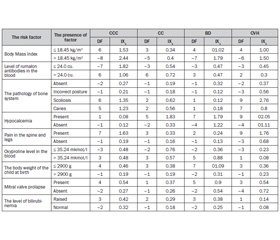Журнал «Боль. Суставы. Позвоночник» 2 (18) 2015
Вернуться к номеру
Diagnostic Criteria of the Bone Mineral Density Reduction in Children with Hepatobiliary Pathology
Авторы: Kinash M.I., Loboda V.F., Dzyuban L.V. - Ternopil State Medical University named after. I.Ya. Horbachevsky, Ternopil, Ukraine
Рубрики: Ревматология, Травматология и ортопедия
Разделы: Медицинские форумы
Версия для печати
Статья опубликована на с. 88-89
Introduction. Preclinical diagnostics of metabolic bone pathology in children is of great importance for the prevention of osteoporosis (OP), its timely correction and formation groups of high risk for osteopenic syndrome.
Aim: To develop methods of predicting the osteopenic syndrome in children with disorders of hepatobiliary system with the following development of forecasting algorithm.
Materials and methods. Comparative analysis of risk factors for OP development based on the history of life, results of clinical and laboratory investigation and densitometrical examination allowed to select 9 signs which were considered as informative diagnostic criteria of preclinical OP development.
Results. Results of a consecutive detection procedure, based on the review of ordered series of signs in the comparison groups and the sequential analysis of selected pairs of distribution, are presented in the table 1.
The process of forecasting is as follows: in every patient we have determined the value of each risk factor, which corresponds to a specific diagnostic factor, in the order they are presented in the table. Then diagnostic factors were added until one of the thresholds has not been reached. If the threshold A2 = +13 was achieved or exceeded, then with a probability of 95 % the risk of reduced bone mineralization in a child can be predicted. If the threshold is A1 = –13, with the same probability the risk of pathology can be denied. If the threshold of ±13 was not reached the next decision was made: there was not enough diagnostic information for resolving the issue with the planned reliability level and it is necessary to continue to study risk factors (undefined response).
Conclusion. Retrospective analysis of risk factors for the osteoporosis development in examined children has demonstrated a relatively high accuracy (87.9 %) of osteoporosis prediction using the presented table, so that allows to recommend it for revealing the probability of bone mineral density reduction in certain patients with hepatobiliary disorders.


/89/89.jpg)